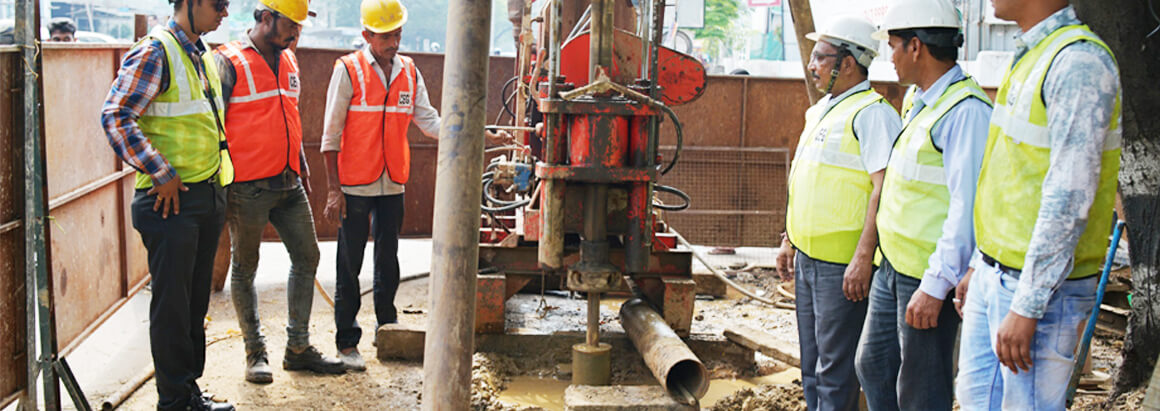Contact Info
- Phone +91-141-4046599
- Mobile +91-98297-46596
- info@cegtesthouse.com
Ask The Expert
Geotechnical Tests

Drilling in Soil & Rock
Geotechnical Drilling is done to determine SPT value, for disturbed & undisturbed soil sample collection, and for coring in rock up to the required depth to perform suitable laboratory testing. It helps in establishing subsurface strata type, condition and engineering properties.
Boring activity through soil strata is carried out in accordance with IS 1892. The diameter of the borehole shall be 100/150 mm in soil. The borehole advanced with adequate diameter guide casing up to the required depth of the borehole. However, if bedrock is encountered, drilling is undertaken by a conventional (NX) size double/triple tube core barrel as per IS 4464.
Drilling with the Rotary method by using suitable rigs as per strata condition shall be planned, like- Mechanical Power Wrench, Hydraulic/Calyx Rotary Core Drill Rig, Flushing Medium, SPT by Auto Trip Hammer or Conventional Manual Method, Double/Triple Tube Core Barrels fitted with Diamond Tipped / TC Core Bits, Drilling Rods and Casing.
Our Geotechnical Drilling Capabilities Include:
- A fleet of over 50 Hydraulic & Rotary Drilling Rigs with drilling capacity of upto around 300m depths
- Application of Auto Trip SPT Hammer in Soil, Double/Triple Tube Core Barrel in Rock Drilling
Static Cone Penetration Test
Static Cone Penetration Test is one of the most popular and widely accepted soil investigation methods worldwide. It is used to establish an in-situ geotechnical characterization of ground and helps in evaluating end bearing and skin friction of soil for continuous profiling up to specified depth or refusal, whichever is earlier. These measurements permit interpretation of ground conditions and its application in many geotechnical engineering aspects such as ground improvement, foundation recommendation, compaction, tank base settlement, etc
Vane Shear Test
Vane Shear Test is performed to find out the in-situ shear strength of soils. It is most appropriate to determine the shear strength of saturated clays, especially those having ‘soft’ to ‘firm’ consistency, and sensitive soils that are highly susceptible to sampling disturbances.
The vane shear test, as per IS-4434, involves pushing a four-bladed vane in the soil. It is rotated till a cylindrical surface in the soil fails by shear. The torque required to cause this failure is measured and converted to a unit shearing resistance of the cylindrical surface.
Permeability Test
Permeability is the ability of soil/rock to allow water to pass through it. Permeability testing is done as per IS: 5529 Part 1 & Part 2 for soil and rock, respectively for several engineering conditions such as calculation of pumping capacity for excavation/dewatering, design of cut off wall for earth dam and determination of aquifer constants of subsurface strata. Following are the various types of permeability tests that we perform:
- Constant Head Method – It is a laboratory & field experiment, and the soils that are mainly suitable for this test are non-cohesive soils.
- Single Packer Method – In this method, one packer is used in the drill hole. In this case, the test section lies in between the bottom of the borehole and the packer.
- Double Packer Method – In this method, two packers are used in the drill hole. In this case, the test section lies in between the two packers.
- Falling Head Method – It is used for fine-grained soils with intermediate and low permeability, such as cohesive soils.
Plate Load Test
Plate Load Test is an on-site testing method used to determine soil’s ultimate bearing capacity and the likely settlement under a given load. It is also used to verify the compactness of ground filling by establishing subgrade modulus and elasticity value. The Plate Load Test involves loading a steel plate at the foundation level and recording the settlements corresponding to each load increment as per IS 1888.
